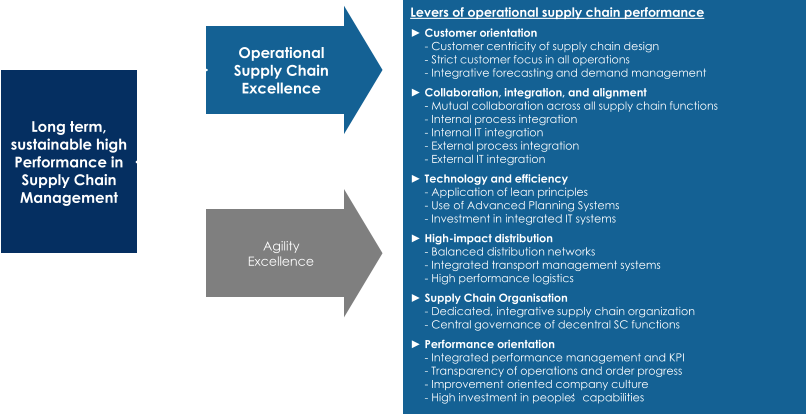

- Value Chain Excellence
- Company Business Performance
- Supply Chain Performance
- Supply Chain Strategy
- Integrated business management (S&OP)
- Digital Transformation
- Operational Improvement
- Transparency
- Complexity
- Agility
- Responsiveness
- Customer Needs
- Delivery Reliability
- SC Segmentation
- Inventory optimization
- Throughput Times
- Order Management
- Planning Excellence
- Cost management
- Logistics Cost
- Working Capital Optimization
- Supplier Optimization
- Transport Optimization
- Network Optimization
- Post Merger Integration
AGILITY: KEY TO SURVIVAL IN A COMPLEX, VOLATILE WORLD

Source: Bölzing, D., Erfolgsfaktoren SCM - Agilität und Organisation, Logistik-Heute 11 + 12, 2015


Leaders strive for operational excellence and agility excellence
Today’s volatile business world requires a different approach than the efficiency-
oriented decades of the past. Agility in the value chain, and in the supply chain,
has become a key requirement to cope with slow as well as sudden changes.
Typically, there are two types of agility:
•
On an overall organizational level, it addresses the capability of the
organization to adapt quickly to new general business challenges. Examples for
this are channel volume shifts, emergence of new business models, new types
of customer interaction, or major regional shifts.
•
On an operational level, it stands for the capability of the organization to adjust
the supply chain to shifts in demand, supply, and in its product portfolio. This
requires a specific kind of flexibility in production, distribution, and sourcing.
What we have seen in our market research is that successful companies who are
nimble and agile, always have already mastered the challenges of implementing
operational excellence in their operations. These techniques build the foundation
to have a fast, customer centric, cost-effective and high perfoming supply chain.
Operational supply chain
excellence is based on six
areas of using advanced
practices

Agility excellence in supply
chains is based on six areas
of using practices based on
early insights, and speed to
implement
Leaders build agility excellence into their organizations
In order to cope with the constant and ever increasing challenges from today’s
volatile business world, companies have started to establish mechanisms which
help them to have systematic insights into the nature of changes in their relevant
business environment. This requires a new focus on what is really important for the
company. Second main area to achieve is to systematically build enablers for fast
response to changes, and consequent adaptation into all areas of the
organization.
Leaders build key enablers for agility excellence into their operations
In our studies and observations, we have identified some key methods and
operational practices leading companies apply. These refer to a “hard tools
area”, but predominantly they are from a “soft foundation” of leadership
principles.
Enablers for agility excellence
in supply chains consist of
8 areas of integrative
methods and tools across the
company, and 4 leadership
and organizational practices
Source: EY SCM Study 2015;
EY Agility Study 2013
Source: EY SCM Study 2012, 2015















